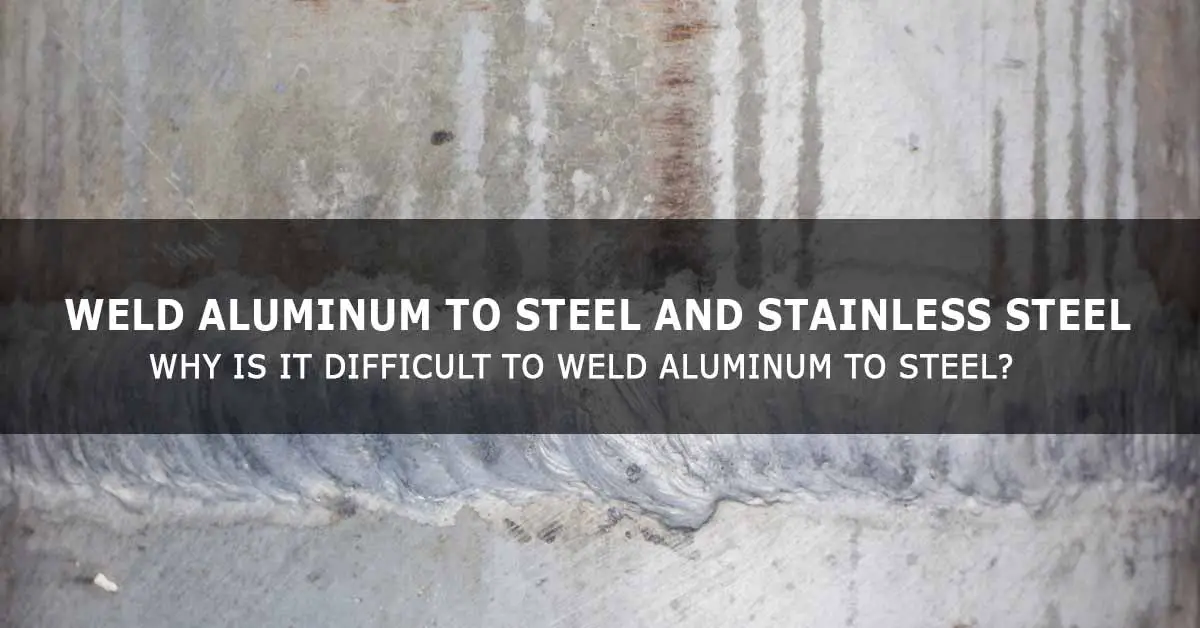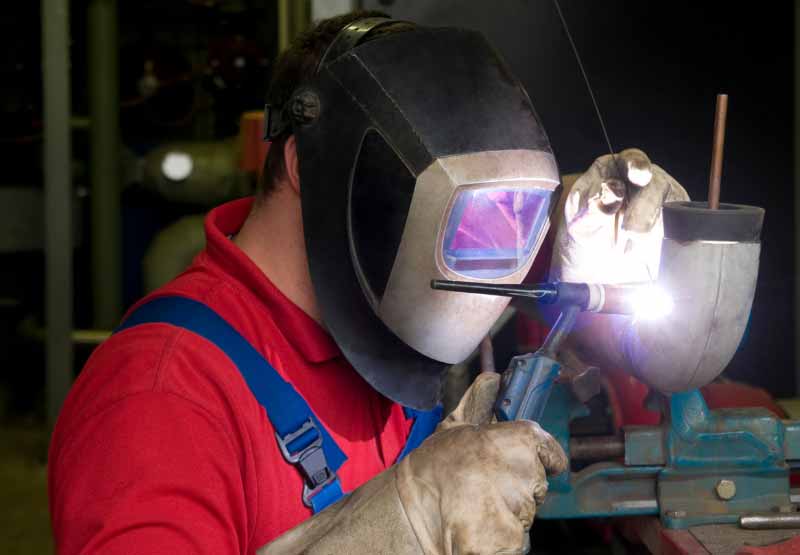On their own, both aluminum, steel, and stainless steel are highly weldable metals. If you keep things in your own backyard and weld aluminum to aluminum, steel to steel, or stainless steel to stainless steel, you are going to have no problems whatsoever. However, if you decide to cross streams and join, for example, aluminum to steel, it is where problems start to happen, and your life becomes considerably agonizing.
So, can you weld aluminum to steel? The short answer is Yes. But how to do it requires a lot of welding prowess. Our guide is here to help with the techniques that are going to enable you to weld aluminum to steel and stainless steel.
Why do we need to weld aluminum to steel or stainless steel?
When compared, aluminum alloys are considerably lighter than steel. The usual density of aluminum is around 2.70 g/cm3 compared to steel which is about 7.75 to 8.05 g/cm3. This means that steel is roughly three times heavier than aluminum.
Steel is used within a variety of industries for structural applications due to its strength. But it also comes with a weight penalty. For instance, some industries require the use of lighter materials which steel is definitely not. Some vehicles with a steel structure are too heavy and produce higher emissions, making them unusable according to new gas emission and environmental laws.
Since it is not possible to replace an entire structure with aluminum only, mixing things up and joining aluminum to steel is the best solution. However, this is not as easy as you think, as traditional welding techniques like SMAW (arc welding), GMAW (MIG), or GTAW (TIG) are unusable in this case.
Why is it difficult to weld aluminum to steel?
Aluminum and steel have very different physical and metallurgical properties. Their thermal conductivity and melting points are very different, making them almost impossible to join. Besides these characteristics, they are virtually insoluble in the other.
Once within their molten state, they react by forming brittle intermetallic phases. This presents a great challenge when joining these materials together when trying to arc weld them. The result would be a weld with unsatisfactory properties. It can be too brittle and thus undesirable for most industries and applications.
Differences between aluminum and stainless steel
As we mentioned, aluminum and stainless steel have some stark properties that make them virtually unweldable to each other. The characteristics that welders need to be aware of are as follows:
- Melting point – Aluminum’s melting point is at 1,221 °F, opposed to 2,500 °F that steel has. Adding to the complexity of welding is the aluminum oxide layer that has a melting point of 3,700 °F.
- Thermal conductivity – Aluminum has a five times greater thermal conductivity than steel, which means more heat is being drawn away from the weld pool and towards the cooler parts of the base aluminum. More heat will cause stainless steel to warp.
- Service temperature – The strength of aluminum will increase as the service temperature decreases. However, steel becomes more brittle as the service temperature decreases.
- Current type – When TIG welding aluminum, you require an alternating current. The electrodes need to alternate between positive and negative charges. Positive electrodes will blast away the oxide layer, while negative electrodes will melt away the base aluminum. TIG welding steel requires a direct current and for the electrode to be negatively charged at all times. However, TIG welding aluminum with a direct current will not allow you to break through the oxide layer, thus combining the filler metal with the partially melted oxide layer and resulting in a contaminated weld bead.
- Hydrogen reactivity – Hydrogen causes cracks in steel welds, while when it comes to aluminum welds, it may cause porosity once atmospheric hydrogen is trapped and creates bubbles as the weld solidifies.
Check our article: 6 Best Aluminum TIG Welders on the Market in 2022
Why we can’t TIG weld aluminum to stainless steel
The easiest way of joining two pieces of metal together would be if the two types of materials are as similar to each other as possible. However, when joining two pieces that are contrasting to each other will make your work significantly harder. The more differences are introduced, the more monkey wrenches are thrown into your welding work.
Material thickness is important to note on its own, but it gets much more complicated when there are other variables to consider, such as aluminum vs. stainless steel composition. These variables can be controlled as a welder can adjust the amperage, the electrode material, and the exposure time. But at some point, there are going to be too many variables to consider, which will make any sort of adjustments impossible.
This is the case when TIG welding aluminum to steel or stainless steel, as the metals are too contrasting to each other, making this method obsolete.
Welding processes to join aluminum to steel and stainless steel
Since you can’t TIG, MIG, or stick weld aluminum to steel, there are some other options that can do the trick. Bimetallic transition, brazing, aluminizing, and bonding are some that can be tried.
Bimetallic Transition
Bimetallic transition is a suitable method mainly used for working on ships, pipelines, or heat exchangers. It involves an insert that is actually aluminum on one side and steel on the other side. These inserts are thick enough, so you can use regular GMAW or GTAW welding techniques to join aluminum to aluminum on one side and steel to steel on the other.
These inserts are pre-bonded by using explosion welding, or hot rolling, or hot pressure techniques. They have a very sturdy welded connection and can handle a lot of force. According to ML specs, their tensile strength is 1/4 the tensile strength of aluminum, but they usually come at 1/2, which is still enough.
Unfortunately, these products are costly and very hard to find, mainly if you are a hobbyist.
Brazing
Brazing is a possible solution but requires a lot of skill to complete appropriately. It does not have the same amount of strength as explosion welding does. To set everything in place, a welder will need an enormous surface area and a solid mechanical fit to set everything properly and prevent it from falling apart.
You can start by wetting the steel with a 56% silver braze. Be sure to use an Aluxcor 4047 aluminum brazing alloy to be able to join aluminum to wetted steel. A two-stage brazing method will have much better results than a single-stage process.
Aluminizing
Aluminizing steel is a process that involves a metal that has gone through a hot-dip process with an aluminum-silicon alloy. It can also be done using galvanic coating, but the hot-dip method is the most common one. However, this method is not really practical if you plan to join large pieces of aluminum and steel.
With this method, you will only be able to weld aluminized steel to regular steel. Don’t get your hopes up of being able to join a block of aluminum to aluminized steel. This is because when you get to a temperature that can melt the underlying steel, the thin aluminum coating will be long gone.
Bonding
Using a bonding agent like epoxy is another suitable way of joining aluminum and steel. However, it will not give you a solid connection as welding the two together.
What you need is a large surface area to work and a tube of JB Weld. It is essential to clean out both pieces as best as possible and scuff out the surfaces to create more bonding power. Some really high-end products are also available, but they are much more expensive and come with significantly longer cure times.
Related article: How To Weld Aluminum Castings
Conclusion
Can you weld aluminum to steel? Sure, why not. But the process is not as easy as you may think. Conventional welding methods simply do not work as these two types of materials are too different compared to each other.
So resorting to other methods is the only possibility. If all else fails, the least that you can do is use mechanical fastening. You only need to make a quick trip to the hardware store.
References:








